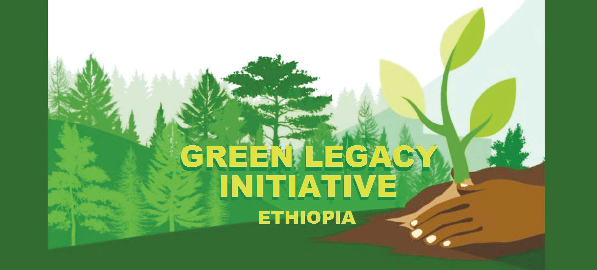
This year, Ethiopia is ready to plant more than 7 billion trees across the country through the National Green Legacy Initiative which has been in full operation for the last five years.
Several decades back, about 40 per cent of the landmass of Ethiopia was reportedly covered by natural forest. Excessive dependence on bio-fuel for firewood at household level, alarming deforestation and land clearing for agriculture, climate change induced drought and run off from the highlands of the country leading to degraded lands, over grazing by livestock all led to unprecedented densification and loss of natural flora and fauna of the country. Ethiopians in the rural and urban areas heavily depended on bio-fuel resources with no effort to replace them.
The NGLI is not just about planting billions of trees every year. Notwithstanding the essence of the campaign in popular parlance, there is more to the NGLI. The author of this article wishes to dwell upon five important issues that relate to the wider understanding and implementation of the program.
Of course, the Initiative is a home grown effort to restore the ecosystem in Ethiopia and in this respect it is a national undertaking in form. However, the content of the program is certainly global and universal.
First, the writer believes that qualitative and scientific reporting on the achievements of the program is very important because tree planting must be accompanied with scientific national reporting and documenting system that could be used for various purposes. Such reports could serve as a point of departure for deeper scientific research on the nature of the flora in the country, their species, ecological compatibility, survival rate and the level of their adaptability to fluctuations on weather conditions.
The extent to which the NGLI is promoting watershed management in rugged areas of the country and how the program is becoming instrumental in restoration of the natural vegetation of the country can be reported in a more quantified manner.
In many parts of the country where watershed management has been conducted, many of the wild animals who fled their original habitat tend to come back to their localities in view of the fact that surface water and vegetation have now been restored. The GLI has proved to be instrumental in promoting the survival and restoration of wildlife across the country.
Moreover, students at all levels including universities and other research centers can use these reports not only as a source of raw data but also as sources of new findings in scientific cognition of the Ethiopian forest resources. In addition, trees planted across the country could be a showcase on educating the young generation of this country on how the planted trees could help to restore soil and water resources of the country and help to recover the alienation between nature and human beings.
The reports to be prepared annually on the progress of NGLI could be documented in the form of online reporting and preparations of video footages that could be reinterpreted by researchers in the field of botany, plant science, herbarium and other related areas of research.
The national report on GLI also needs to include the history of the planed trees from nursery to the planting site and the rate in which the trees survive over time. The types of trees planted including specific fruit trees and trees that could be used for herbal medicine can be properly documented.
Second, it must also be noted that the NGLI is not a standalone national project but needs to be perceived as an important component of the national macroeconomic development of the country. This would mean that there is an important linkage between agriculture, wildlife conservation, tourism development, education, health research and conservation of indigenous species of plants that could be used for the economic development of the country. The initiative needs to be blended and integrated with program implementation of the various sectors of the national economy and current national development campaigns like Yelemat Trufat and Ethiopia Tamirt programs. Ethiopia needs to diversify and develop foreign export which could include forest resources from the GLI
Third, the author is of the opinion that the digitalization of the NGLI will not only help to develop an updated national reporting on the program but will also help to share knowledge on developments on the vegetation in the country. In this respect, The Ethiopian Space Science Society and ground satellite facilities can provide reliable scientific information on the overall progress of forest development in the country.
Fourth, Ethiopia possesses traditional plants and herbs that used among the population to help cure various diseases. Similar traditional medicines are also prescribed by traditional healers very few of whom are recognized and certified by the Federal Institute of Public Health. More than 7,000 herbal, mineral and animal medicinal resources out of which 1,500 are ingenious are so far recorded. Although researchers have been conducted on some 70 types of herbs, only 13 have been identified as viable herbal medicines while 5 are registered at the Ethiopian Intellectual property office. Researches indicate that there are 14,000 persons who practice herbal medicine in the country but only 40 of these are registered and certified by the Ministry of Health. This has also stunted the growth of the sector.
Fifth, one of the most important aspects of the GLI is the legal technical prerequisite for the protection all of the trees planted across the country. Just like any natural resources of the nation, these trees need to be legally protected by instituting legal provisions that provide for the protection of flora in the country.
It is to be recalled that Ethiopia has also embarked on World Bank sponsored carbon projects which were introduced as a means of reducing thousands of tons of carbon in the earth’s atmosphere to make our earth more habitable while generating more income for communities in the project areas.
The author of this article is conscious of the fact that thousands of herbs and trees and species of indigenous crops have been smuggled out of the country to be planted in foreign countries in illegal manner. Just like our heritages that have been looted over the course of several decades the Ethiopian ingenious plants are also being looted. The Ethiopian Bio-Genetic Institute is operating at its level best to conserve our indigenous plant species some of which are close to extinction. The Institute is working with international partners and stakeholders to institute effective protection of our indigenous plant resources which also are being subjected to the effects of climate change.
The outputs from NGLI could be maximized through institutional and technical cooperation and integration between all stakeholders in the country not only on planting trees but also on establishing and creating a practical operational link to the national macroeconomic development of the country including ecotourism resorts in the context of tourism development.
The author is again of the opinion that the GLI could be supplemented with the development of household woodlots, backyard bio-intensive vegetable gardening and community owned woodlots for food security, income generation and environmental protection.
Along with planting trees every year, the communities across the country could use the occasion for cross cultural exchange and peace building in their respective residential areas. This is an important occasion on which participants from various ethnic groups, professions and age groups come together to share their experience while developing a common culture of tree planting.
This year’s GLI coincided with a massive corridor development initiative that was introduced by Prime Minister Abiy Ahmed as part of the national program for promoting clean and green cities all along the country. Corridor development was accompanied with planting ornamental trees along road sides and centers adding more beauty to Addis Ababa in particular.
The NGLI also added a new feature to the development of a comprehensive macroeconomic policy developed by the country over the last several years as an offshoot of the Home Grown National Economic Policy introducing a new and the first of its kind macroeconomic policy in Africa. This is a unique national plan in the sense that it blended climate change mitigation with economic development policy.
In terms of foreign policy and diplomacy, the NGLI was instrumental in forging Ethiopia’s diplomatic relations with the neighboring countries and the international community and global agencies at large. Despite the challenges the country has continued to face, it helped to further strengthening the visibility, positioning and rooting Ethiopia among the nations of the world.
Nevertheless, the Imitative will certainly influence the sectoral development programs of the country with a special emphasis on education. It would help to create a climate sensitive generation which would develop and care for the forest resources of the country as a heritage for their future livelihood.
The author wishes to stress on the need for effectively documenting the achievements so far registered in the form of educational films for children and the youth. This is very important to ensure the transfer of GLI to the next generation of Ethiopians who are expected to develop it to a higher level.
There is no doubt that a lot has been achieved in promoting the GLI in Ethiopia but even then, there is more to be done by way of ascertaining the sustainability of the initiative.
However, much depends upon the extent to which Ethiopians are ready to work towards a sustainable peace in the country because promoting green legacy in the country is best served when lasting peace is achieved in the country. Although the road may seem to be uphill battle Ethiopia shall inevitably prosper.
BY SOLOMON DIBABA
THE ETHIOPIAN HERALD WEDNESDAY 21AUGUST 2024




